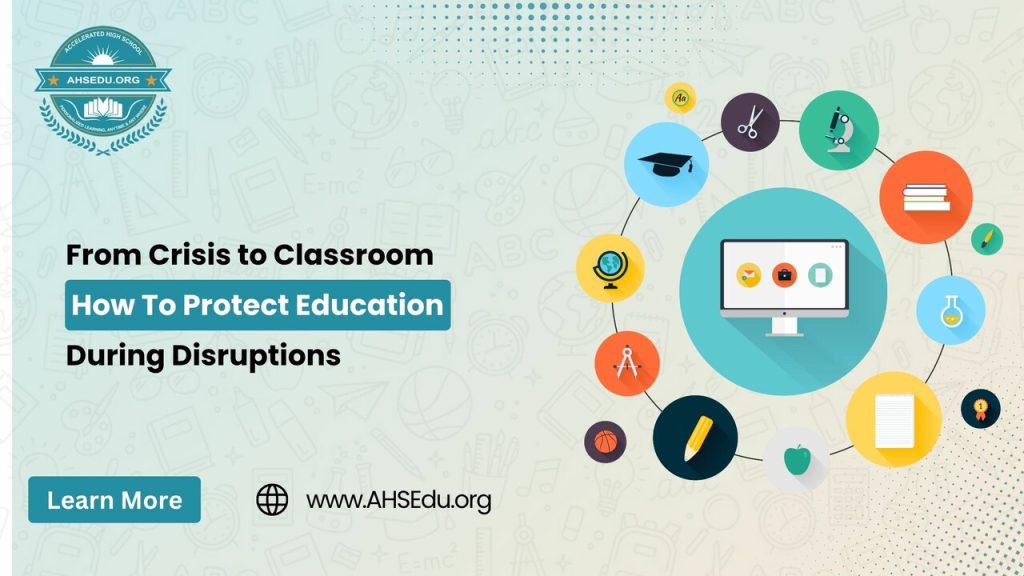
When schools shut down; whether due to pandemics, conflict, natural disasters, or infrastructure failures; children don’t just lose school days. They lose momentum, confidence, and opportunity. Over the past few years, education systems around the world have revealed just how vulnerable they are to disruption. Yet amid this fragility lies a critical question: What if classrooms didn’t vanish when school doors closed? What if learning could continue everywhere, no matter the circumstances?
This article explores what triggers education disruptions, the long-term impact on learners, how resilient education systems adapt, and the ways AHS Education is helping protect learning continuity, no matter where or when it’s needed.
What Triggers Education Disruption
Education can be disrupted by multiple, often overlapping crises. Pandemics, such as COVID-19, forced widespread school closures in 192 countries and interrupted learning for over 1.5 billion students worldwide. Natural disasters like hurricanes, floods, and earthquakes frequently damage infrastructure and displace families. In regions affected by conflict and political instability, schools are often destroyed or repurposed for non-educational use, leaving millions of children without safe spaces to learn.
Even in peaceful countries, disruptions occur when basic resources fail — unreliable electricity, poor internet connectivity, transportation breakdowns, or budget shortfalls that prevent schools from functioning effectively.
These problems disproportionately affect marginalized and rural communities, where access to reliable schooling is already precarious. For displaced or low-income students, every day out of school widens a gap that becomes increasingly difficult to close.
The Impact on Learners
The consequences of interrupted education are both measurable and lasting. Research shows that extended school closures can lead to significant learning loss. One global study found that twenty-five weeks of closure resulted in a 0.23 standard deviation drop in student performance — roughly equivalent to losing nearly a full academic year of progress. Students in affected schools also lost an average of one-third of their expected learning gains in reading and literacy skills compared to previous years.

The economic repercussions are just as severe. The World Bank estimates that pandemic-related school disruptions could cost the current generation of students $17 trillion in lifetime earnings. Beyond academics and economics, the impact extends to emotional and physical well-being. Students who depend on schools for meals, structure, and safety face increased risks of malnutrition, anxiety, and disengagement.
In short, when education stops, it doesn’t just pause learning, it dismantles opportunity.
Resilience in Education: What Works
Despite these challenges, several education systems and organizations have developed strategies to preserve learning during crises. Some have adopted offline-first learning models, distributing preloaded tablets, USB drives, or print kits that allow students to continue lessons without internet access. Others rely on hybrid and modular approaches, enabling learners to pick up lessons at any time, even after interruptions.
Community-based facilitation also plays a vital role. In many areas, local volunteers, teachers, and NGOs organize informal study groups, distribute materials, and track progress when schools are closed. Governments, in partnership with non-profits, are increasingly investing in education continuity plans, proactive strategies that ensure instruction continues regardless of circumstance.
During the COVID-19 pandemic, innovation flourished under necessity. In parts of Africa and Asia, solar-powered learning hubs, community radios, and mobile learning vans reached students who otherwise would have been cut off entirely. These creative solutions demonstrate that resilience in education is possible — but it requires foresight, technology, and collaboration.
How AHS Education Safeguards Learning
AHS Education was designed precisely for these moments of disruption. Built as a resilient, adaptable learning ecosystem, it provides continuity in ways that traditional systems often cannot.
Students can access a complete U.S. State Standards–aligned curriculum for Grades 1–5 through video lessons, quizzes, and printable worksheets. Because the platform supports offline and mobile access, students can download lessons and complete them without internet connectivity, syncing their progress later when they’re back online.
Each lesson is modular and independent, allowing learners to move at their own pace and continue where they left off, a critical feature for children facing inconsistent study conditions. Teachers, tutors, and NGOs benefit from real-time dashboards that track learning across individual and group levels, even under asynchronous or remote conditions.
Just as important, AHS removes the barriers that often exclude underserved communities. There are no fees, licenses, or subscriptions required. Schools and non-profits can enroll entire classrooms or communities in minutes and begin teaching immediately, even with limited infrastructure. In this way, AHS functions as an “education insurance policy” — ensuring that when schools close, learning doesn’t stop.
Building a Continuity Culture
Education continuity isn’t just about surviving a crisis; it’s about designing systems strong enough to withstand one. For schools, this means integrating digital platforms like AHS into their regular operations, so when disruption hits, they’re already prepared. Ministries of education can preload AHS materials into their contingency plans, while NGOs can embed it into their emergency education toolkits to keep displaced children learning.
Parents and tutors, too, play a vital role. With AHS, they can guide students’ progress remotely, use offline materials to supplement lessons, and ensure that even when formal schooling halts, the rhythm of learning continues.
The Way Forward
Education cannot be conditional, it must be constant. The next crisis, whether environmental, political, or economic, could arrive without warning. The question is not whether disruption will happen, but whether we are prepared when it does.
By combining accessibility, adaptability, and affordability, AHS Education ensures that every child — regardless of geography or circumstance — has the opportunity to learn, grow, and thrive. It’s not just a digital platform; it’s a lifeline for learning continuity and a model for the resilient classrooms of the future.
To join the movement and keep education alive for every learner:
Visit AHSEdu.org/demo-for-parents for parents,
AHSEdu.org/demo-for-institute for schools,
AHSEdu.org/demo-for-nonprofit for non-profits,
and AHSEdu.org/demo-for-tutor for tutors.
Because education must never stop, not for a day, not for a crisis, not for a generation.

AHSEDU.org offers personalized learning for every student. With a curriculum standardized with USA State Standards, Free interactive videos, Fun and interactive learning content, Constructive assessments, and take-home worksheets we address the unique educational needs of each learner to ensure success.